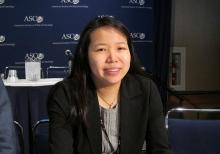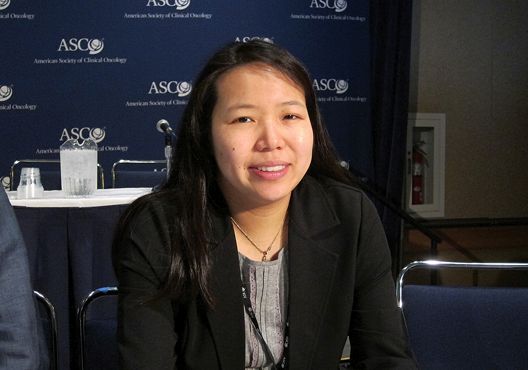User login
Adding seribantumab to paclitaxel did not extend survival as was hoped in unselected patients with platinum-resistant or refractory ovarian cancer, according to a report published online in Journal of Clinical Oncology.
However, exploratory analyses of data from this manufacturer-sponsored open-label phase II trial showed that certain biomarkers might identify a subgroup of patients who may benefit from the addition of seribantumab, said Joyce F. Liu, MD, of Dana-Farber Cancer Institute, Boston, and her associates.
The primary endpoint, median progression-free survival (PFS) in the intention-to-treat population, was 3.75 months with seribantumab and 3.68 months without it, a nonsignificant difference. The objective response rate was actually slightly higher in the control group (18.1%) than in the experimental group (13.6%). No patient showed a complete response to treatment, the investigators said (J Clin Oncol. 2016 Oct. 26. doi: 10.1200/JCO.2016.67.1891).
Toxicities were more frequent in the experimental group, with grade 3 or higher adverse events occurring in 35.7% of the experimental group vs. 30% of the control group, serious adverse events occurring in 42.1% vs. 31.3%, and fatal adverse events occurring in 7.9% vs. 2.5%. In particular, five serious and one nonserious pulmonary embolisms developed in the experimental group, compared with only one nonserious PE in the control group.
However, the investigators also explored whether biomarkers that link directly to seribantumab’s mechanism of action would identify a subgroup of patients who might benefit from the treatment. They found that in the 57 women whose tumors expressed both detectable levels of heregulin RNA and low levels of HER2, the median PFS was 5.7 months with the addition of seribantumab, compared with only 3.5 months for paclitaxel alone. The data suggested that seribantumab acts primarily by blocking the development of resistance to treatment, rather than by inhibiting tumor growth, Dr. Liu and her associates wrote.
Liu et al. should be congratulated for having the foresight to collect the necessary biospecimens to conduct a rigorous assessment of tumor biomarkers.
Even though they did not prove their hypothesis that adding seribantumab to paclitaxel would extend survival, they did identify a potential path forward for this drug in ovarian cancer, salvaging what would have been a negative study. It is critical to improving patient outcomes that we learn from our failures as well as our successes.
Alison M. Schram, MD, is a fellow in medical oncology at Memorial Sloan Kettering Cancer Center, New York. She reported having no relevant financial disclosures; one of her associates reported ties to Atara Biotherapeutics, CytomX Therapeutics, Puma Biotechnology, Loxo Oncology, and AstraZeneca. Dr. Schram and her associates made these remarks in an editorial accompanying Dr. Liu’s report (J Clin Oncol. 2016 Oct 26. doi: 10.1200/JCO.2016.69.7169).
Liu et al. should be congratulated for having the foresight to collect the necessary biospecimens to conduct a rigorous assessment of tumor biomarkers.
Even though they did not prove their hypothesis that adding seribantumab to paclitaxel would extend survival, they did identify a potential path forward for this drug in ovarian cancer, salvaging what would have been a negative study. It is critical to improving patient outcomes that we learn from our failures as well as our successes.
Alison M. Schram, MD, is a fellow in medical oncology at Memorial Sloan Kettering Cancer Center, New York. She reported having no relevant financial disclosures; one of her associates reported ties to Atara Biotherapeutics, CytomX Therapeutics, Puma Biotechnology, Loxo Oncology, and AstraZeneca. Dr. Schram and her associates made these remarks in an editorial accompanying Dr. Liu’s report (J Clin Oncol. 2016 Oct 26. doi: 10.1200/JCO.2016.69.7169).
Liu et al. should be congratulated for having the foresight to collect the necessary biospecimens to conduct a rigorous assessment of tumor biomarkers.
Even though they did not prove their hypothesis that adding seribantumab to paclitaxel would extend survival, they did identify a potential path forward for this drug in ovarian cancer, salvaging what would have been a negative study. It is critical to improving patient outcomes that we learn from our failures as well as our successes.
Alison M. Schram, MD, is a fellow in medical oncology at Memorial Sloan Kettering Cancer Center, New York. She reported having no relevant financial disclosures; one of her associates reported ties to Atara Biotherapeutics, CytomX Therapeutics, Puma Biotechnology, Loxo Oncology, and AstraZeneca. Dr. Schram and her associates made these remarks in an editorial accompanying Dr. Liu’s report (J Clin Oncol. 2016 Oct 26. doi: 10.1200/JCO.2016.69.7169).
Adding seribantumab to paclitaxel did not extend survival as was hoped in unselected patients with platinum-resistant or refractory ovarian cancer, according to a report published online in Journal of Clinical Oncology.
However, exploratory analyses of data from this manufacturer-sponsored open-label phase II trial showed that certain biomarkers might identify a subgroup of patients who may benefit from the addition of seribantumab, said Joyce F. Liu, MD, of Dana-Farber Cancer Institute, Boston, and her associates.
The primary endpoint, median progression-free survival (PFS) in the intention-to-treat population, was 3.75 months with seribantumab and 3.68 months without it, a nonsignificant difference. The objective response rate was actually slightly higher in the control group (18.1%) than in the experimental group (13.6%). No patient showed a complete response to treatment, the investigators said (J Clin Oncol. 2016 Oct. 26. doi: 10.1200/JCO.2016.67.1891).
Toxicities were more frequent in the experimental group, with grade 3 or higher adverse events occurring in 35.7% of the experimental group vs. 30% of the control group, serious adverse events occurring in 42.1% vs. 31.3%, and fatal adverse events occurring in 7.9% vs. 2.5%. In particular, five serious and one nonserious pulmonary embolisms developed in the experimental group, compared with only one nonserious PE in the control group.
However, the investigators also explored whether biomarkers that link directly to seribantumab’s mechanism of action would identify a subgroup of patients who might benefit from the treatment. They found that in the 57 women whose tumors expressed both detectable levels of heregulin RNA and low levels of HER2, the median PFS was 5.7 months with the addition of seribantumab, compared with only 3.5 months for paclitaxel alone. The data suggested that seribantumab acts primarily by blocking the development of resistance to treatment, rather than by inhibiting tumor growth, Dr. Liu and her associates wrote.
Adding seribantumab to paclitaxel did not extend survival as was hoped in unselected patients with platinum-resistant or refractory ovarian cancer, according to a report published online in Journal of Clinical Oncology.
However, exploratory analyses of data from this manufacturer-sponsored open-label phase II trial showed that certain biomarkers might identify a subgroup of patients who may benefit from the addition of seribantumab, said Joyce F. Liu, MD, of Dana-Farber Cancer Institute, Boston, and her associates.
The primary endpoint, median progression-free survival (PFS) in the intention-to-treat population, was 3.75 months with seribantumab and 3.68 months without it, a nonsignificant difference. The objective response rate was actually slightly higher in the control group (18.1%) than in the experimental group (13.6%). No patient showed a complete response to treatment, the investigators said (J Clin Oncol. 2016 Oct. 26. doi: 10.1200/JCO.2016.67.1891).
Toxicities were more frequent in the experimental group, with grade 3 or higher adverse events occurring in 35.7% of the experimental group vs. 30% of the control group, serious adverse events occurring in 42.1% vs. 31.3%, and fatal adverse events occurring in 7.9% vs. 2.5%. In particular, five serious and one nonserious pulmonary embolisms developed in the experimental group, compared with only one nonserious PE in the control group.
However, the investigators also explored whether biomarkers that link directly to seribantumab’s mechanism of action would identify a subgroup of patients who might benefit from the treatment. They found that in the 57 women whose tumors expressed both detectable levels of heregulin RNA and low levels of HER2, the median PFS was 5.7 months with the addition of seribantumab, compared with only 3.5 months for paclitaxel alone. The data suggested that seribantumab acts primarily by blocking the development of resistance to treatment, rather than by inhibiting tumor growth, Dr. Liu and her associates wrote.
FROM THE JOURNAL OF CLINICAL ONCOLOGY
Key clinical point:
Major finding: The primary endpoint, median progression-free survival in the intention-to-treat population, was 3.75 months with seribantumab and 3.68 months without it, a nonsignificant difference.
Data source: A multicenter open-label randomized phase II trial involving 223 patients in North America and Europe.
Disclosures: This study was supported by Merrimack Pharmaceuticals, maker of seribantumab. Dr. Liu reported serving as a consultant or adviser to AstraZeneca and Genentech and receiving research funding from Merrimack, AstraZeneca, Genentech, Boston Biomedical, Atara Biotherapeutics, and Acetylon. Her associates reported ties to numerous industry sources.

